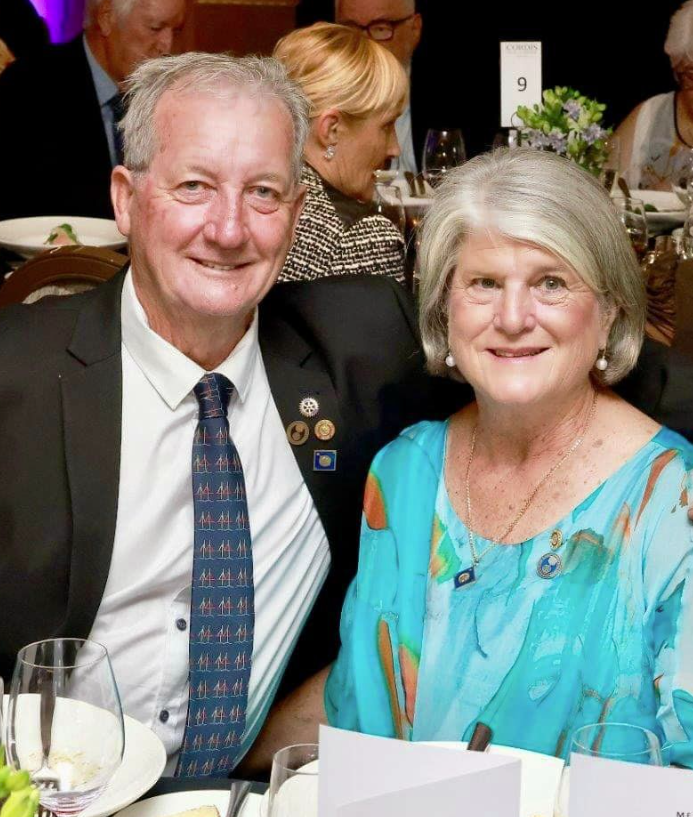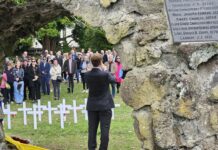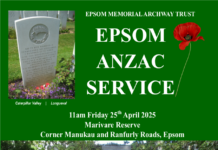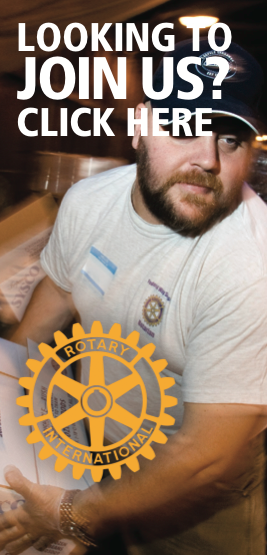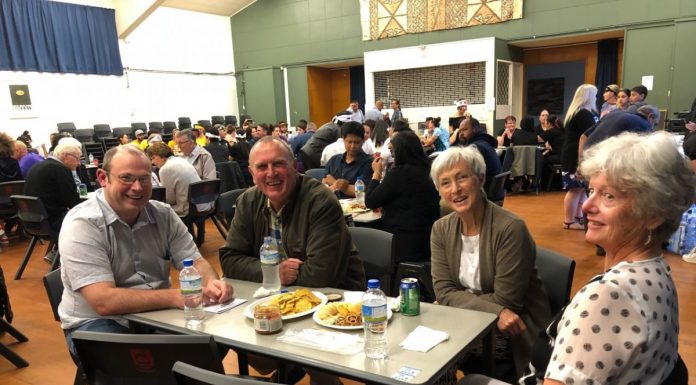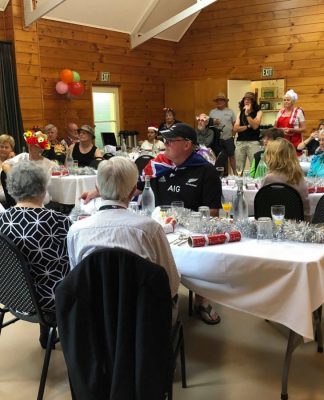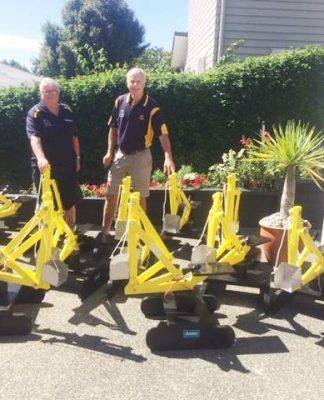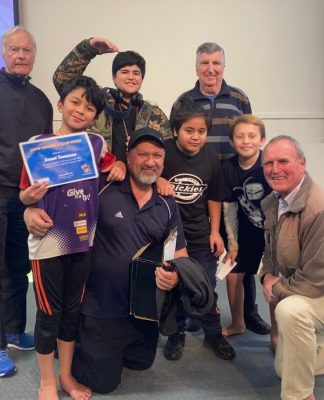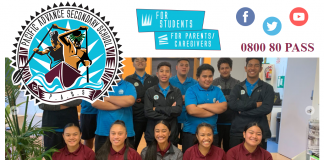Club member Bruce Murdoch welcomed and introduced fellow Rotarian Lindsay Ford, known especially well by members who have worked alongside him on Pacific Island projects over the years as well other from his many visits to us over the last ten plus years. To list Lindsay’s credentials would take nearly as long, suffice to say he’s journeyed from being a club Member through to District Governor (DG) and beyond.
Lindsay was District PolioPlus Sub Committee Chair and a past-appointee to The Rotary Foundation Cadre of Technical Advisors. Lindsay has received a string of Rotary awards including Distinguished Service Award recognising his exceptional service to the Foundation over many years. That aside, Lindsay’s passion is getting involved with many high value Global and Matching Grants, cutting through red tape
to deliver the goods. A fibrous plasterer by trade, Lindsay together with his wife Alison, a nurse, ran a successful contracting business for 35-years. Originally from Bundaberg, the two have also been Norfolk Island residents since 2006.
Lindsay acknowledged it was good to be back at our club again and how sad it was to no longer to see Bede Brittenden in our midst.
[There are two styles Lindsay’s talk to us could have been written up in this Newsletter: ‘reported speech’ outlying key points, or ‘direct speech’ which better relays tone and mood. Lindsay is a great character who is far better portrayed using the latter.]
Over to you Lindsay…
Barry [Stafford] said when he invited me to be the speaker, I could speak about whatever I wanted to, and I thought: you never say that to a past District Governor, but suggested I might talk about my journey in Rotary.
I don’t I don’t suppose people know a lot about what my journey is actually. When I say my journey of course I’m talking about a journey that Alison and I have done together, as we are a team.
I joined the Rotary Club of Bundaberg in July 1998. It was quite a large club fifty-seven all male members. I got invited there on one night and when I walked into the room, I didn’t know anyone, except the guy that invited me along. Not knowing anyone, I didn’t feel comfortable talking to anyone either, so I walked up the other end of the room where they had the Honour Board. This Honor Board included every past leader of our city since the club had started. I thought to myself at that stage: I won’t be coming back because they were all way, way overqualified for me – they’re all professional people, academics and that, and just out of my league.
But they did have a great club Bulletin and it was full of jokes. I’d come from a background of surf lifesaving, about nearly thirty years, and I thought when I joined Rotary, I was going to do raffles – like come along to a meeting like tonight and do raffles because I don’t know who was going to be there, didn’t know anything about Rotary, but that’s what I expected.
I used to go home, and Alison would say, “What’d you do tonight?”, and I said, “Nothing, we didn’t do anything. It was just a guy up there talking about something that I really wasn’t interested in most of the time.” But she used to sit up in bed, wait for this Bulletin to come home and she thought the jokes were great.
I was one of those Rotarians who was going to leave after six months. I didn’t need the fellowship and I was still heavily involved with lifesaving [Life Member of Elliott Heads Surf Lifesaving Club]. I was a surf boat rower and very competitive, and so just coming to Rotary just took up far too much time – until someone asked me to be International Service Director of the club.
So, I go home with my ‘joke book’ and Alison asked, “What happened tonight?” I said, “Nothing – there was someone up there talking about stuff I wasn’t interested in, but I’m going to be the International Service Director,” and she said, “What’s that?” I said, “I don’t know.”
Well, they gave us a book and at that stage, RAWCS (Rotary Australia World Community Service), the same as what’s here in New Zealand, they had all these pages of projects. I just thought: someone gives you the book and you picked a project out. So I picked a project called Sixteen Shelters in India, in a place called Paonta Sahib, which is virtually right in the middle of India.
At the next meeting I said, “I think we should do this project in India.” They said, “Okay, we’ll do that,” and passed it.
No one knew what a Matching Grant was – I didn’t even know what it was. We didn’t even know how to draft it and it was only the fourth matching grant in Queensland at the time. This was about the beginning of June 2000, and someone said to me, “Don’t worry about it, you won’t get it approved this year, wait and do it next year like first of July on.”
Now I hate people telling me what to do – especially telling me I can’t do something. So, I sent this document over to the Paonta Shaib DG in India and made fifty-four phone calls one after another. Ring-ring-ring, drop-out, ring-ring-ring, drop-out, ring-ring-ring, drop-out, answer, drop-out, fifty-four times until DG Arun Sharma, answered the phone.
Arun was the District Governor 1999-2000 of Paonta Sahib District 3080 and I said, “Sign that paper and send it back.” We got it back, submitted it, got it approved by end of June, and that was a fantastic project.
I was happy with that, and then I heard that a lady had lost her life from one of the outer islands in Papua New Guinea, giving birth to a baby on the beach and couldn’t get it to the hospital – no ambulance.
I’d heard Queensland ambulance occasionally auction their ambulances – there’s nothing much wrong with them – so I sent them a letter and said, “Why auction it off to some fisherman to drive up the beach on Fraser Island? Give it back to us,” because our club at that stage had funded three ambulances for Queensland Ambulance Service (QAS). They said, “No. The ambulance is promised to a Federal member, Teresa Gambaro from Brisbane, that she’d get the ambulance to New Guinea,” virtually saying, ‘mind your own business, go away.’ So I rang them every two weeks for two years, saying, “How’s the ambulance going?” Same story, “Go away, Theresa Gambaro is going to do this.”
Then one day I got a call from QAS and they said, “What are we going to do with the ambulance?” I said, “What do you mean? Theresa Gambaro is doing it all,” and he said, ‘No, she can’t do it. So, what we’re going to do is we’re going to auction it off and you could have the next one.” I said, “No way, no, that’s mine, I want it. I can get it there next week.” He said, “Okay, you can have it then.” I though: Shit, how am I going to get this ambulance to New Guinea? I didn’t have a clue!
I went to the Federal member, Paul Neville, who was a member of our Bundaberg Rotary Club. He used to sit up at the desk and I’d be sitting back and by the time we finished talking, I’d be up at his desk and he’d be sitting back, and he said to me, “Is there an airport there where you want it to go in New Guinea?” I said, “Lae, it’s only 50 miles from Alotau”.
Now, I don’t know if anyone’s been to New Guinea, but 50 miles, I don’t know in the war how those soldiers even took a step through that bush – you couldn’t even walk off the road. Anyway, he said, “Okay, I’ll take it back to the Federal Government Defence Minister, I’ll see what I can do.”
A couple of days later, I’m at work and he rang me up and he said, “Lindsay, this has moved really quickly, you’re going to get a call from the Air Force today.” I was shaken, I’m thinking; Holy hell!
I went home, and the phone rings and it was a load-handler from RAAF Base at Williamtown and he said, “You’ve got an ambulance here to go to New Guinea?” I said, “Yep,” and thought: I didn’t have any ambulance! I said, “Yep, I’ve got it.”, and he said, “We’ll, come on and pick it up Monday [this is Thursday!]”. I said, “No worries, but hang on, you have to come to Bundaberg and get it because it’s in Bundaberg, it’s not in Brisbane. You’ve got to come here.” I said, “Okay, we’ll be in Bundaberg.” Oh, I thought and hung up. [Bundaberg is 1,100km north of RAAF Base Williamtown which is 180km north of Sydney]
I picked up the phone and rang the QAS – the people who told me I couldn’t have the ambulance. I said, “That ambulance is going to New Guinea next week, Monday, we’re coming down Saturday to pick it up.” They said, “Oh, shit, we had a storm here last night, a tree fell over and broke the windscreen – we’ve got to get that fixed, and you’ll see the Ambassador of New Guinea – you’ve got to get some photos.” I said, “That’s okay, I’m coming to get it.” I drove down and got it and drove it back to Bundaberg.
There’s an associated story with this. At that time our last President, Sid Yates was in hospital. Being a bit blasé I went to the hospital and said, “I want him Sid at the airport Monday when this big C-130 [military transporter] arrives,” and they said, “He’s sick, he can’t come, but you go and ask him.”
So, I went in and said, “Sid, we’ve got your ambulance back, I want you to
come out the airport. Do you want to come?” He said, he “didn’t think anyone cared.” He started crying, and so did I.
So long story short, I talked the Ambulance crew into getting him out of hospital, and the RAAF load-handlers guided him through that plane. He died five days later.
Before the plane came, they rang me up and they said, “Oh we’ve got some news for you,” and I said, “I’ve got some news for you too,” because they didn’t know anything about the ABC reporter and they said, “Oh, we’ve had to change the nose on the plane and we’re going to be late.” [this was a special flight for the delivery of the ambulance]. I said, “That’s okay – and we’ve got an ABC reporter that wants to go with you, to cover the ambulance handover.” They said, “Oh yeah she can come, but we’re not bringing her back, we are flying on to Bougainville Island.” So, she couldn’t go and we had to come up with another plan.
As a result of that, Sid’s son, who was also called Sid [Jnr], was a manager of the Olympic Games squad from New Guinea, rang up and said, “You should come up and hand that ambulance over.” I never do things like that and then Alison said, “You should go, it’s just ridiculous, why don’t you do it?” So, I decided that we’d go, and I asked him to get me a quote. Sid [Jnr] got a quote from Air New Guinea, and he said, “I got you a good price, $1,200 return.” I thought: that didn’t sound cheap to me.
I wrote a letter to Air New Guinea and asked them to be part of the project, explain it all and got the fares for $350. I got up at our Rotary Club meeting, just like this, and said, “We’re going up to New Guinea and we’re taking a female ABC reporter Rachelle Loakes with us. She couldn’t go with the ambulance, but she can go with us.”
At that stage New Guinea didn’t like the ABC and I didn’t know that the reporter could come anyway, but I said to the club, “We’re taking her, and you guys are going to pay for her.” A club member, PDG John Kerr stated his legal firm would pay her fare and confirmed that would happen.
We flew up there to hand the ambulance over, but the real reason I wanted to go, was to look – as I’m always looking for projects. The hospital situation up there was just a shocker. In Australia we used to go out to the dump (as we all do to dump rubbish once upon a time), and there’d be lots of timber there. I had an idea that we could get the timber out of the dump and take it to the Salvation Army Depot in Bundaberg, where they run the Drug Rehabilitation make furniture and school desks– to give them something to do.
When I went up to New Guinea, I had an idea to send up containers of hospital and education equipment and bring back timber from areas of PNG so we could make desks and get this rotation going – making products in Bundaberg for PNG, send them there by container and filling the returned containers with timber and so on. There was a lot of corruption up there at that time, at all levels, and unfortunately the logistics, reliability and trust could not enable this to proceed.
Anyway, we shipped 28’x20’ sea containers of hospital and education equipment free of charge. We were the only Rotary Club in Queensland that got free rail freight from Townsville down to Bundaberg (1,000km) return. We had container trucks picking containers up, delivering them out to our site, free of charge.
In Bundaberg I asked local businessman, John Santaluchia, for the use of a really big shed – we could fit about 20 containers in there. He said, “How long do you want it for?”, I said, “Six months,” and he said, “Okay.” Six years later we still had that shed and it was still free and that was fantastic.
We delivered all this good hospital and medical stuff from Queensland – if you weren’t in Rotary you’d be writing letters to the editor. Things like, Bundaberg Base Hospital put in a new dishwasher at $140,000 who found out after three months use it couldn’t handle it, so they gave it to us and we sent it up and put it in Port Moresby Hospital.
In another hospital, the air filters in the operating rooms had been all rewired. They worked out they were going to go to the Mackay Hospital but couldn’t get them out. We had solicitors in our club, and I rang them up and said, “What are you guys doing this afternoon at five o’clock?” and they said, “Dunno,” and I said, “I do, get up to the hospital, we’re taking all the doors off.” We took all the air filters down there, got one into a lift downstairs, loaded them into my family’s pantec [furniture] truck, out to the storage shed, and they ended up in Port Moresby Hospital as well.
A huge amount of work and a lot of background stuff goes on to make these things happen. When I left the Bundaberg club I just said, “It’s just the KISS method, you would have heard it – Keep It Simple Stupid,” but no, too much effort was required by them and sadly that stopped after six months.
Back in India, the project I started was taking a fair while to complete, and I was in the building game and just couldn’t handle just how slow it went. It took over 12 months to complete [in 2000]. Alison and I decided that we’d go to India and participate in the National Immunization Day (NIDS) for polio where they immunize 160-million kids in one day – which was pretty awesome.
We were lucky enough to go with the World Health Organisation in the days after that and go through the slums to a place called Merrett, north of Delhi. It was a life changing experience – when we came out there, we were different people.
As a result of that Bundaberg Rotary club [2004/5] nominated me to Chair a committee of Past-presidents of another five clubs where we all decided to do a Centennial project to build a house which they wanted to raffle off. I said, “No way.” Alison and I were big time fundraisers, and I knew what we would be in for, and it wasn’t going to happen. I said, “No, not a raffle, you’d have to auction it off.”
So they made me the Chairman and I never saw them again, I just heard the feedback was, “It wouldn’t happen, it just couldn’t happen.” When I heard these Rotary presidents say it couldn’t happen, I was determined to make it happen.
I called a guy I knew on the way home; Dennis Ryan was his name. He used to do plans for a firm that I did work for, and I said, “I want a plan done of a four-bedroom house, double garage and I don’t want to pay for it.” He said, “Come in and sit down.” Well, that afternoon we named every single person that would work on that house for free – from woe to go, and that did happen.
We built that house in twelve months. I remember when we did the floor. The first day, we had eight competing concreters turn up to do the floor when only one had been invited, but eight turned up. That scale of giving went through the whole the whole house for over a year. Me and a mate, Ross Edwards, a Rotarian in the club worked on that house every weekend for a year.
We auctioned that house off and made $300,000 profit with the two main beneficiaries being Polio and ROMAC. It was ROMACS’s biggest donation they’d ever received. They had a lot of heavyweights at a thankyou dinner in appreciation, and the Australian government matched the polio donation one-for-one, I think was $150,000 max, so it was huge!
In 2006, Alison and I moved to Norfolk Island and I thought my Rotary days were over. There was a Rotary Club there and it took me a long time to join it because that was terrible club. When one of the women would speak, the guys would tell her to “Shut up” and say she didn’t know what she’s talking about. That’s not me, so I didn’t want to join, but I did hear the hospital needed hospital beds and they were doing a runway upgrade, and I knew people in Boral Industries and asked if they’d bring a sea container hospital beds over from Donations in Kind (DIK) Brisbane which they did, for nothing, and we replaced all those hospital beds in one fell swoop.
I did eventually join the Norfolk Rotary club [31 Dec 2006], then I couldn’t shut up regards the issues that needed to be fixed, (I can shut up when I need to) and there was lot of bloodletting and it had to be done and hopefully, I can say the club’s way, way better. What I can also say in the bloodletting, I didn’t stab anyone back, I told them what I thought to their face, and we ended up being good mates because of that.
I got the opportunity then to come down to the District 9910 Rotary Foundation meetings in Auckland, and I found that only the people sitting around the table at the meeting had the benefit of the Grants and that to me was wrong, so I knew I was going to change that.
In 2012-13, when I became 9910 District Governor, I did my rounds. I’d never been to Vanuatu and when I came back out of Vanuatu I said to our District Committee, “We’ve got a third world country in our district we’ve got to do something for them.” They told me it was a basket case and said, “If you want to do something for them, you do it yourself – you Chair it.” I said, “Yep, I will, and you can shove your money, I don’t want any of your money,” and they said, “Well what are you going to do for money?” I said, “You wait and see.”
Well, the story goes like this. When I came in as District Governor I said, “We’re going to do a Matching Grant for ROMAC, I don’t care how you do it, just do it.” We needed a partner, so we got a partner out of Korea. The Korea D3730, DG, was so impressed with the proposal they invited us up to do a District Sister Agreement and that’s what we still have in place.
I remember going up there, Keith Day was with me, Mrs Youngshin Watkins (from Takapuna Rotary) and Alison. We all sat out at the table and there was half a dozen of District 3730 members all dressed up with a suit and tie, as we did too.
We looked across the table didn’t even know if they could speak English, didn’t even know what we’re going to say, and D3730 The Rotary Foundation Chairman, looked across the table straight at me and said, “Sixty years ago you helped us fight a war – and now we’re ready to repay.” Every time I say it, I get goosebumps. I said, “Well we’re here to establish a relationship of trust where we can trust each other where we can work with each other and where we can do things for our communities,” and we walked out of there with a promise of USD 350,000.
This was for Rod Kessel’s Godden Memorial Hospital project and he nearly fell over when we came back. I said, “We got all your money,” and also to Peter Wilson from Rotary Whangaparaoa for the Napangasale High School Renovation Project in Tongoa, Vanuatu.
Since the Vanuatu project, our committee has remained small, and we only reach out to those when we want them or for advice or help. We really keep it small – it’s virtually Keith Day and me, and we’ve done probably over forty Global Grants and it’s been a wonderful experience.
There’s been a lot of a lot of times when you could walk away from this but when you look at those kids faces or those people’s faces that we’re trying to help you got to focus on that and then realise [be more determine] that no one will stand in our way.
In 2017 I was lucky enough to be appointed as a cadre for the Rotary Foundation where I drafted projects up. I’ve worked with a lot of Australian clubs who know very little about Global Grants because they have this other system, Rotary Australia World Community Service (RAWCS). In 2022/23 RAWCS raised AUD $15.4m [-27.7% $21.3m 2021/22] for projects so they don’t need the Rotary Foundation funding, and so they know very little about what we do.
So where to now? We’re going to keep doing what we’re doing. Keith Day, PDG Neil Murray, DRFC Grant Smith, Alison and I are going up to Vanuatu in a couple of weeks. We can’t hand over Rod’s Vanuatu project located in Enkul Village on Pentecost Island, because of the cyclone there. Where we’re going to stay is being blown away and they don’t have any food there now and so we put that on hold – but we do have to go up there.
Last Thursday we applied for a Disaster Grant to the Rotary Foundation. We got it approved Friday night and that was for US$25,000 to help that Enkul community in Pentecost where that project is [Cyclone Lola hit the island early hours 23 Oct 2023]. That’ll be supplying seed, rice, water, chainsaws, oil, petrol, that sort of thing to help those people recover.
We do have some exciting things happening in our world and we’ll keep you posted with that as they happen.
I’ve been lucky enough to have some great people from our district and I’d like to thank, especially this club, especially Rod Kessel, bloody annoying at some times, but shit, he’s got some good projects. We wish him the best of health, mate, we really do.
That’s about me, that’s been my journey,
Q&A session
Did you meet the Dalai Lama?
When we went to India, someone said to me, “Do you want to meet the Dalai Lama?” and I said, “Oh, I don’t care, whatever” because I’m focused on the Rotary, I don’t really care much about anything else. Anyway, they took us up to see him and only one person could have a camera. We got a photo of Alison and me with the Dalai Lama holding the Norfolk Island Rotary Club banner. Someone asked, “What’s the Dalai Lama like?” and I said, “Oh, just an old bloke with a crook back and a deep voice.”
What’s the latest with Regionalisation?
It’s a new model and a three-year pilot. The whole idea is where we’ve got 4 or 5-clubs in an area, the future model is they want those areas to be 25-clubs minimum. It can be 25, 35, 40 clubs, it doesn’t matter – but preferably 25. So, they’ve got to work out your club, all our clubs, all the clubs across Australia and New Zealand are going to work out who they want to clump with.
The second idea, which is an option, is that a club can also join a specific Focus Group and that could be from anywhere in Australia, New Zealand and it could be a focus on youth exchange, on projects or whatever, that’s an option.
They also had a vote for positions on the Regional Council which closed last Thursday. Only 56% of clubs voted but that’s those decisions have been made. I think that if you have only got 56% of clubs voting, it’s not a good look for Regionalisation, to me, but hopefully that will change, but that all depends on our clubs and our members.
What’s the premise behind it – is it to amalgamate, cut down the actual number of regions?
We’ve been talking about re-districting for quite a while and I think that many people saw lots of obstacles in the way especially like District 1020 didn’t want to do with us, and there’s probably others as well. There’s been a lot of re-districting in Australia. My former District, 9570, went from Maryborough to Mackay and out to Longreach. That district now goes from just north of Brisbane, right up north to the tip of Cape York and out west includes Darwin – that’s huge. Another redistricting is Western Australia which is one district now, so if you look at the map, that’s a big place.
I think the whole idea with Regionalisation was to stall re-districting and come up with another model. When you clump these 25-clubs they’re going to elect 100 Rotary leaders across Australia and New Zealand. That will get rid of all AGs – they will be new Rotary Leaders. Above them are the nine Council positions. So you’ve got Rotary clubs of 25 with a Rotary leader above them and then there’s these positions where you can liaise with to get help with membership, projects or whatever. It’s a three-year pilot.
I really want it to succeed but if it doesn’t, I think we are going to see a change in Districts. Eventually the District Governor rolls will go which will reduce costs but I really don’t think it’s going to change anything a Rotary club does. Clubs are autonomous, they’ll still do whatever they want to do as it’s up to them, but they’ll have a broader spectrum of people that they can call upon and hopefully that’ll be okay.
I was recently interviewed for a RI Director role and I went down there just to tell them what I thought about Rotary – I’m passionate about it so I wasn’t to have a sledge. But I figured if we keep going down the same road we’re going to keep going down the same road and I said to them if ever Rotary needs leaders they need it now. My expectation is people want something from a leader they want the leader to lead they don’t want a leader in name only and we have a lot of those people in Rotary that you know just want to be something and that’s all they want to do.
I see so many issues with Rotarians and Rotary clubs and the difficulties they’ve got to be involved with project and as their membership gets older. What I want from a leader is if I want to do a project somewhere and I haven’t got the money I want the leader find the money and that was the only reason why I wanted to be RI Director or be involved in the Regionalisation is, I wanted to have some sort of responsibility where I could walk in to the Prime Minister of Australia and say “That overseas funding, that aid that you’re given to Vanuatu you know it’s getting stolen. I know it is because we’re involved with projects up there and I know what’s happening with the projects and how the Vanuatu government can’t perform. So, I don’t want the $100m that they’re given them, I only want $500,000 but boy when we do the project for $500,000 and we’re accountable, transparent and we report then I want $1m then I want $2m, and we can do it faster, better and half the cost.
They’re places up there that have been hit with the cyclone five years ago and still the government don’t care because they’re corrupt and that’s reflective in probably five governments in five years.
Anyway that’s me, I’m just going to keep doing what we’re doing and fight hard for Rotary and our Rotary Club so yeah, thank you.
Can you tell us about the recent award you got?
Yeah, it was a bit of surprise to receive it at the Rotary Foundation Dinner on Saturday night. I think they also raised well over a million dollars for the Rotary Foundation and recognised a lot of people. I recognised Keith and Margaret Day for their contribution to the Foundation, many, many, many, many thousands of dollars along with a lot of other people there.
At the end of the night, they gave out an award called the Rotary Distinguished Service Award, which is the highest award in the world from the Rotary Foundation. There’s only 50 people in the world that get that each year and that was me – so that was pretty cool, yeah.
On behalf of the club, Barry Stafford thanked Lindsay coming as Guest Speaker.
Barry couldn’t imagine a more, fair dinkum Australian. surf lifesaving, a boatman, someone who speaks the same lingo as many Australians and who ranges around the Pacific and is successful because he follows the belief that if you don’t ask, you’re never going to find out.
Barry said our club shares with pride what Lindsay has done in the name of Rotary around the Pacific and in India. That we value the relationship our club has with him and how our club punches above its weight and we hope that will continue.
Barry finally thanked Lindsay for his frank assessment about what’s happening in Rotary today and to both him and Keith Day for keeping an eye on the Te Tai Tokerau Mental Health Wellbeing project up north which is largely attributable to Lindsay. We hope that’s going to be a success and to keep doing what they’re doing.
We need to take a few lessons away, and we will.
(6th Nov 2023)

